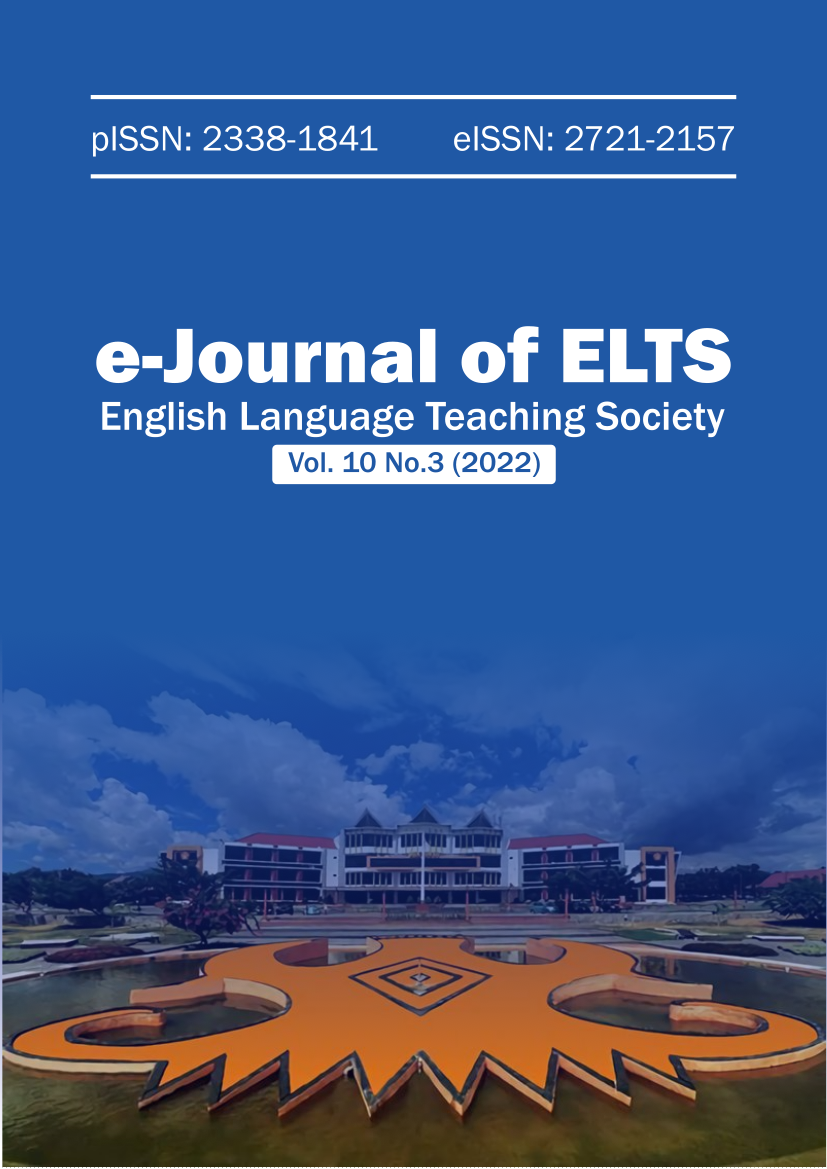PROBLEM FACED BY THE RURAL AREA STUDENTS IN LEARNING ENGLISH SPEAKING
DOI:
https://doi.org/10.22487/elts.v10i3.3180Keywords:
English Speaking, Problem, Rural AreasAbstract
This research focuses on students who live in rural areas in learning English speaking. The objective of the research is to find out the problems in speaking skills and to find out the causes of speaking problems in speaking skills encountered by the eighth-grade students of MTs.Muhammadiyah Tolitoli. MTs Muhammadiyah School was located in Baolan district, Tolitoli regency, in Central Sulawesi. The method of this research is qualitative research method while the sample of this research was the eighth-grade students of MTs. Muhammadiyah Tolitoli was chosen by convenience sampling. Observation, interviews, and Questionnaires were the tools of data collection. Based on the data collected from questionnaires, interviews, and observations, it was found that skill factors are the most dominant problem than knowledge factors. It was found that 80% were problems with lack of confidence, 60% were problems with less motivation, and 60 % had problems with feeling shy in learning English speaking. It is followed by the knowledge factor which means a percentage of 72% the aspect of knowledge in learning speaking, 56% pronunciation, and 52% lack of vocabulary. The causes of speaking problems encountered by the eighth-grade students of MTs. Muhammadiyah Tolitoli is inhibition, environment, and mother tongue used.
References
Ayu, S. R. 2018. An Analysis of the Students’ Problem in Learning Speaking at the First Semester of the Eleventh Grade Students of SMKN 6 Bandar Lampung in the Academic Year 2018. Unpublished Doctoral Dissertation. State Islamic University Raden Intan Lampung.
Brown, H. 2007. Principles of Language Learning and Teaching. (5th ed) New York: Logman.
Handayani, U. D. 2019. English Teachers’ Strategy in Teaching Speaking. Published Skripsi. Institute of Islamic Studies, Ponorogo, Indonesia.
Harmer, J. 2007. The Practice of English Language Teaching. Malaysia: Pearson Education Longman.
Harris, D. P. 1974. Testing English as a Second Language. New Delhi: Tata McGraw-Hill Publishing.
Heaton, J. B. 1991. Writing English Language Testing. New York: Longman.
Juhana. 2012. Psychological Factors That Hinder Students from Speaking in English Class. Tanggerang.
Kumaravadivelu, B. 2006. Understanding Language Teaching from Method to Postmethod. London: Lawrence Erbaum Associates Publisers.
Ladouse, 1991. Evaluation of Speaking. Urbana: National Council of Teachers of English.
Leong, L.,M. & Ahmadi,S.,M. 2017. An Analysis of Factors Influencing Learners’ English Speaking Skill. International Journal of Research in English Education,2(1),34-41 ,
Retrieved from : http://ijreeonline.com/article-1-38-en.pdf
Palaiologou , I., Needham, D., Male, T. 2016. “Analysing Qualitative Data”. Doing Research in Education: Theory and Practice. London: SAGE, 177-191.
Margono. 2010. Metode Penelitian Pendidikan. Yogyakarta: Renika Cipta.
Maulidar, K., Gani, S. A., & Samad, I. A. 2019. Teacher’s Strategies in Teaching Speaking for Cadets. English Education Journal (EEJ), 10(1), 80-94.
Mead, N. A., & Rubin, D. L. 1985. Assessing Listening and Speaking Skills. Eric Digest.
Mills, G. E. & Gay, L. R. 2016. Educational Research: Competencies for Analysis and Applications (eleventh ed.). London: Pearson.
Purnomo, H. 2018. The Implementation of 2013 Curriculum in English Lesson at SMP Muhammadiyah 1. Surakarta. Doctoral dissertation, Universitas Muhammadiyah Surakarta.
Rao, P. S. 2019. The Importance of Speaking Skills in English Classrooms. Alford Council of International English & Literature Journal (ACIELJ), 2(2), 6-18.
Shteiwi, A.,A. & Hamuda.,M.,A. 2016. Oral communication Problems Encountering English Major students : Cause & Remedies. International Journal of Social science and Humanities 4(2).19-26.Retrieved from :
https;//www.google.com/url?sa=t&rct=j&q=&esrc=s&source=web&cd=1&cad=rja&uact=8&ved=2ahUKEwjc_pqRyebkAhXPblAKHbphBuQQFjAAegQIABAC&url=http%34%2F%2Fwww.researchpublish.com%2Fdownload.php%3Ffile%3DORal%2520communication%2520Problems-3077.pdf%26act%3Dbook&usg=AOvVaw23Pn5P-7hUyrTcmKpBiqJ
Stainback, S, and Stainback, W. (1988). Understanding and conducting Qualitative Research, Kendall/Hunt,Dubuque,IA.
Stern, H.H. 1991. Fundamental Concept of Language Teaching. New York: Oxford University Press.
Sugiyono. 2012. Metode Penelitian Pendidikan Kuantitatif, Kualitatif and R&D. Bandung: Alfabeta.
S, Zhang. 2009. The role of input, interaction, and output in the developmentof oral fluency. English Language Teaching. New York: Oxford University Press.
Tarigan. 1990.Teknik Pengajaran Keterampilan Berbahasa. Bandung : Angkasa
Thornbury, Scott. 2005. How to Teach Speaking. New York: Pearson Education Limited.
Ur, P. 1991. A Course in Language Teaching (Practice and Theory). UK: Cambridge University Press.
Yuniasti, N. K. 2021. An Investigation of Speaking Difficulties Encountered by the Eighth Grade Students’ of SMP Negeri 9 Palu. Unpublished Doctoral Dissertation. Palu: Tadulako University of Palu.
Downloads
Published
How to Cite
Issue
Section
License
Copyright (c) 2023 Zarah Amelia H. Basri, Sriati Usman, Abdul Kamaruddin, Wahyudin Wahyudin

This work is licensed under a Creative Commons Attribution-ShareAlike 4.0 International License.
Authors who publish with e-Journal English Language Teaching Society (ELTS) agree to the following terms:
- Authors retain copyright and grant the journal right of first publication with the work simultaneously licensed under a Creative Commons Attribution License (CC BY-SA 4.0) that allows others to share the work with an acknowledgment of the work's authorship and initial publication in this journal.
- Authors are able to enter into separate, additional contractual arrangements for the non-exclusive distribution of the journal's published version of the work (e.g., post it to an institutional repository or publish it in a book), with an acknowledgment of its initial publication in this journal.
- Authors are permitted and encouraged to post their work online (e.g., in institutional repositories or on their website) prior to and during the submission process, as it can lead to productive exchanges, as well as earlier and greater citation of published work.








